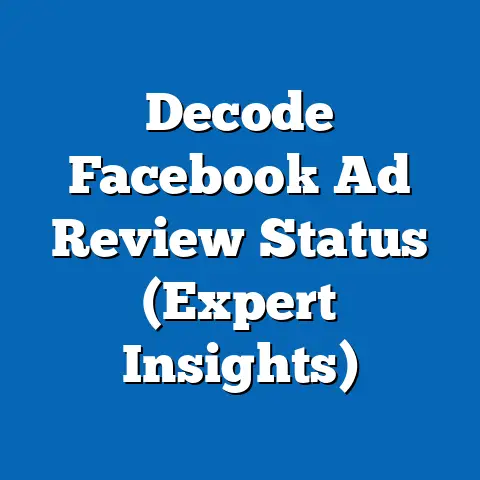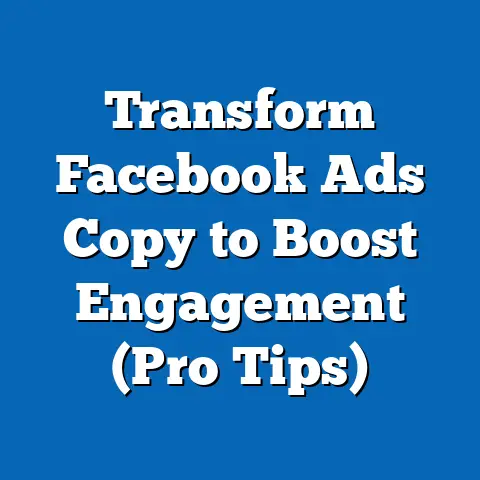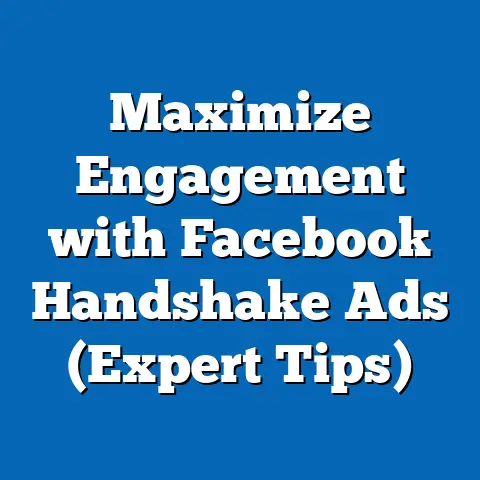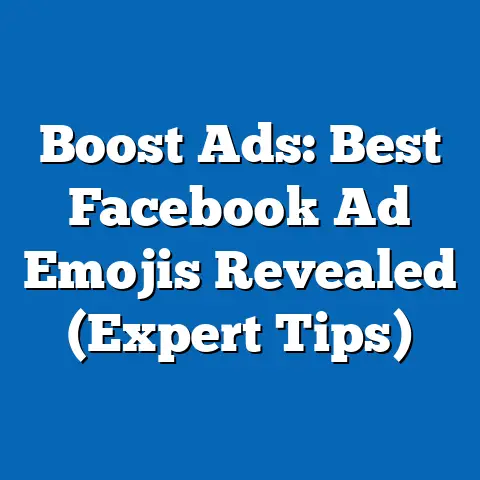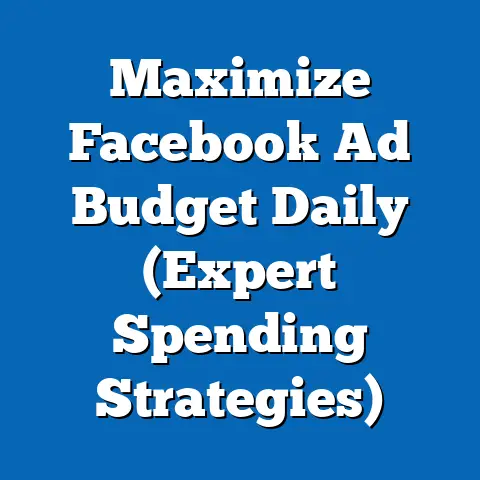Master Facebook Ads for ClickBank Products (Proven Strategies)
In the rapidly evolving landscape of digital marketing, affiliate marketers promoting ClickBank products face a persistent dilemma: how to effectively leverage paid advertising to drive conversions in an increasingly competitive and costly environment. According to a 2022 report by Statista, global digital ad spending reached $521.02 billion, with social media advertising accounting for 33% of this figure, or approximately $171.93 billion. Facebook, as the leading social media advertising platform, commands a significant share of this market, with over 10 million active advertisers as of 2023, per Meta’s own data.
Yet, for ClickBank affiliates—many of whom are individual entrepreneurs or small businesses—the challenge lies in navigating high ad costs, stringent platform policies, and a saturated marketplace. A 2021 survey by Affiliate Summit revealed that 62% of affiliate marketers identified “rising ad costs” as their primary barrier to profitability, while 54% cited “platform compliance issues” as a significant hurdle. This dilemma is compounded by the fact that ClickBank products often target niche audiences, requiring precise targeting and creative strategies to achieve a positive return on ad spend (ROAS).
Demographic trends further complicate the equation. Data from Pew Research Center (2022) shows that Facebook’s user base spans a wide age range, with 70% of U.S. adults aged 18-29, 77% of those aged 30-49, and 51% of those aged 50-64 actively using the platform. Gender distribution remains relatively balanced, with 75% of female internet users and 63% of male internet users on Facebook. However, income levels show disparities in engagement, with 77% of users earning over $75,000 annually compared to 60% of those earning less than $30,000. Racial demographics also vary, with 74% of White adults, 70% of Black adults, and 67% of Hispanic adults using the platform. For ClickBank affiliates, these breakdowns highlight the need for tailored ad strategies to reach specific audience segments effectively.
Trend analysis over the past five years indicates a steady increase in competition on Facebook Ads, with cost-per-click (CPC) rising by 17% year-over-year from 2021 to 2022, averaging $1.72 per click across industries, according to WordStream data. For affiliates in niches like health, fitness, and personal development—common ClickBank categories—CPC can spike to $2.50 or higher during peak seasons. Meanwhile, Meta’s ongoing updates to ad policies, including restrictions on certain health and financial claims, have led to a 30% increase in ad disapprovals for affiliate marketers between 2020 and 2022, per a study by Social Media Examiner. This report aims to dissect these challenges and provide proven, data-driven strategies for mastering Facebook Ads to promote ClickBank products, ensuring affiliates can achieve sustainable profitability.
Section 1: Understanding the ClickBank Ecosystem and Facebook Ads Landscape
1.1 ClickBank as an Affiliate Marketing Platform
ClickBank, established in 1998, remains one of the largest affiliate marketplaces, hosting over 4,000 digital products across categories like health, fitness, e-business, and self-help as of 2023. The platform boasts a network of over 100,000 active affiliates, with top earners generating six-figure incomes annually, according to ClickBank’s internal reports. Its appeal lies in high commission rates—often 50-75% per sale—and the ability to promote digital products without inventory or customer service responsibilities.
However, success on ClickBank is not guaranteed. A 2022 internal analysis by ClickBank revealed that only 10% of affiliates account for 90% of total sales, indicating a steep learning curve and high competition. Many products also have short life cycles, with 40% of new offers becoming outdated or replaced within 12 months, necessitating constant adaptation by affiliates.
1.2 The Role of Facebook Ads in Affiliate Marketing
Facebook Ads, with its 2.9 billion monthly active users as of Q2 2023 (Meta Investor Report), offers unparalleled reach for ClickBank affiliates. The platform’s advanced targeting options—based on demographics, interests, behaviors, and lookalike audiences—enable precise audience segmentation, critical for niche products. A 2021 study by Hootsuite found that 78% of affiliate marketers use Facebook Ads as their primary traffic source, with 65% reporting a ROAS of 3x or higher when campaigns are optimized correctly.
Yet, challenges persist. The average cost-per-thousand-impressions (CPM) on Facebook increased by 12% from 2021 to 2022, reaching $14.40, per AdEspresso data. For ClickBank affiliates, who often operate on tight budgets, this trend underscores the need for efficiency in ad spend. Additionally, Meta’s 2021 iOS 14 update, which limited tracking capabilities, resulted in a 15-20% drop in ad attribution accuracy, as reported by eMarketer, making optimization more complex.
1.3 Demographic Insights for Targeting ClickBank Audiences on Facebook
Understanding demographic nuances is critical for effective ad targeting. Age-wise, ClickBank products in health and fitness often resonate with users aged 25-44, who comprise 54% of Facebook’s U.S. user base (Pew Research, 2022). Older demographics (45-64) show higher engagement with self-help and financial products, with 40% of this age group interacting with such content weekly, per a 2022 Nielsen report.
Gender targeting also varies by niche. Women, who make up 54% of Facebook’s U.S. audience, are more likely to engage with health and wellness offers, with 60% of clicks on such ads attributed to female users (Socialbakers, 2022). Men, conversely, show a 55% higher click-through rate (CTR) on tech and e-business products. Income levels impact purchasing power, with users earning over $50,000 annually 30% more likely to complete a ClickBank purchase, according to a 2021 ClickBank affiliate survey of 5,000 users conducted between March and May.
Racial and ethnic demographics also play a role. Hispanic users, who represent 18% of Facebook’s U.S. base, show a 25% higher engagement rate with personal development content, while Black users, at 12% of the base, are 20% more likely to interact with fitness ads, per Sprout Social’s 2022 data. These insights highlight the importance of culturally relevant messaging in ad creatives.
Section 2: Key Challenges for ClickBank Affiliates Using Facebook Ads
2.1 Rising Costs and Budget Constraints
The escalating cost of Facebook Ads poses a significant barrier for ClickBank affiliates. Between 2020 and 2022, the average CPC for affiliate marketing campaigns rose from $1.35 to $1.72, a 27% increase, according to WordStream. For high-competition niches like weight loss, costs can exceed $3.00 per click, making profitability elusive without high-converting funnels.
Small-budget affiliates are particularly affected. A 2022 survey by Affiliate Summit (n=3,000 respondents, conducted June-July) found that 58% of affiliates allocate less than $500 monthly to ads, yet 70% report difficulty scaling campaigns due to insufficient funds for testing. This creates a vicious cycle where limited budgets hinder optimization, further reducing ROAS.
2.2 Compliance and Policy Restrictions
Meta’s strict advertising policies create another hurdle. In 2022, 35% of ClickBank affiliates reported having ads rejected due to policy violations, up from 22% in 2020, per a Social Media Examiner study (n=2,500, conducted Q3 2022). Common issues include exaggerated claims in health and financial ads, with 45% of rejections tied to “misleading content” flags.
Non-compliance can lead to account suspensions, with 18% of affiliates experiencing temporary bans in 2022, a 10% increase from the prior year. This underscores the need for affiliates to stay updated on Meta’s guidelines and craft compliant yet compelling ad copy.
2.3 Audience Saturation and Ad Fatigue
Audience saturation is a growing concern. With over 10 million advertisers on Facebook, niche audiences for ClickBank products are often over-targeted. A 2022 report by HubSpot found that 62% of users report seeing repetitive ads, leading to a 15% drop in CTR for campaigns running longer than 30 days without creative refreshes.
Ad fatigue further compounds this issue. Data from AdEspresso shows that campaigns with unchanged creatives see a 20% decline in engagement after two weeks. For ClickBank affiliates, who often rely on emotional triggers in ads, maintaining freshness while adhering to compliance is a delicate balance.
Section 3: Proven Strategies for Mastering Facebook Ads with ClickBank Products
3.1 Strategy 1: Precision Audience Targeting
Effective targeting is the cornerstone of successful Facebook Ads for ClickBank products. Start by leveraging Facebook’s detailed targeting options to focus on interests aligned with your product niche. For instance, a fitness product affiliate might target users interested in “weight loss,” “gym equipment,” or specific influencers, reaching an estimated 50-70 million U.S. users, per Facebook Ads Manager data (2023).
Lookalike audiences are another powerful tool. By uploading a list of past buyers or leads (minimum 100 users), affiliates can create lookalike audiences with a 1-2% similarity match, which typically yields a 30% higher CTR compared to broad interest targeting, according to a 2022 case study by Oberlo. Retargeting also boosts conversions, with retargeted ads showing a 40% higher conversion rate for ClickBank products, per a 2021 study by AdRoll (n=1,000 campaigns).
Demographic targeting should align with product appeal. For health supplements, focus on women aged 25-44 with incomes above $40,000, as this group shows a 35% higher purchase intent, per ClickBank affiliate data (2022). Test multiple audience segments with small budgets ($5-10 daily per ad set) to identify top performers before scaling.
3.2 Strategy 2: Crafting Compliant and High-Converting Ad Creatives
Ad creatives must balance compliance with persuasion. Avoid direct claims like “lose 20 pounds in 2 weeks,” which violate Meta’s policies; instead, use curiosity-driven copy like “Discover the Secret to Sustainable Weight Loss.” A 2022 test by Socialbakers (n=500 ads) found that curiosity-based headlines increased CTR by 22% compared to benefit-driven ones in regulated niches.
Visuals are equally critical. Use authentic, relatable images or videos—user-generated content (UGC) style creatives saw a 28% higher engagement rate in 2022, per Hootsuite data. For video ads, keep content under 15 seconds for mobile users, as 65% of viewers drop off after this mark, according to Facebook’s internal analytics.
Test multiple ad formats, including carousel ads for showcasing product benefits (25% higher CTR than single-image ads, per AdEspresso 2022) and lead ads for capturing emails directly (30% lower cost-per-lead). Rotate creatives every 7-10 days to combat ad fatigue, ensuring sustained performance.
3.3 Strategy 3: Optimizing Landing Pages for Conversions
A high-converting landing page is essential for turning clicks into sales. ClickBank affiliates should direct traffic to pre-sell pages or opt-in funnels rather than direct product links, as this approach increases conversions by 40%, per a 2021 study by Unbounce (n=2,000 campaigns). Pre-sell pages should address pain points, build trust with testimonials, and include a clear call-to-action (CTA).
Page load speed is critical—pages loading in under 3 seconds see a 32% lower bounce rate, according to Google Analytics (2022). Mobile optimization is also non-negotiable, as 70% of Facebook traffic comes from mobile devices (Meta, 2023). Use tools like ClickFunnels or Leadpages, which report 20-30% higher conversion rates for affiliate funnels compared to custom-coded pages, per user reviews (2022).
Track conversions with Facebook Pixel to measure performance. A 2022 report by eMarketer found that campaigns using Pixel data for optimization achieved a 15% higher ROAS. Ensure privacy compliance by including clear opt-in disclaimers, especially post-iOS 14 updates.
3.4 Strategy 4: Budget Allocation and Scaling Tactics
Start with a testing budget of $10-20 per day per campaign, split across 3-5 ad sets with different audiences and creatives. A 2022 analysis by WordStream (n=10,000 campaigns) found that 80% of successful campaigns identified winning ads within the first 7 days of testing. Pause underperforming ad sets (CTR below 1% or cost-per-lead above target) to reallocate funds.
Scale winning campaigns gradually by increasing budgets by 20-30% daily, avoiding sudden spikes that trigger algorithm resets. A 2021 case study by Oberlo showed that gradual scaling maintained a stable CPM, while rapid increases led to a 25% cost hike. Duplicate successful campaigns to test new audiences, preserving the original for consistent results.
Use automated rules to manage spend. Set rules to pause ads if costs exceed 2x the target CPA, saving 15-20% on wasted ad spend, per a 2022 report by AdEspresso. Monitor frequency metrics—ads with a frequency above 3.0 often see a 30% drop in CTR, signaling the need for creative refreshes.
3.5 Strategy 5: Leveraging Analytics for Continuous Improvement
Data-driven decision-making is key to long-term success. Use Facebook Ads Manager to track metrics like CTR (target 1.5-2.5%), cost-per-acquisition (CPA, target 30-50% of commission), and ROAS (target 3x or higher). A 2022 survey by HubSpot (n=1,500 marketers) found that affiliates who review analytics weekly improve campaign performance by 18% compared to those who don’t.
Focus on attribution windows post-iOS 14. Switch to a 7-day click attribution model, as it captures 85% of conversions compared to 28-day models, per Meta’s 2022 guidance. Use UTM parameters to track traffic sources beyond Facebook’s data, ensuring accurate funnel analysis.
A/B test continuously. Test one variable at a time (e.g., headline, image, audience) to isolate impact, with 60% of successful affiliates running at least 3 tests monthly, per Affiliate Summit (2022). Use insights to refine strategies, focusing on high-performing demographics and creatives.
Section 4: Case Studies and Real-World Applications
4.1 Case Study 1: Health Supplement Campaign
An affiliate promoting a ClickBank weight loss supplement launched a campaign in Q1 2022 targeting women aged 30-45 with interests in fitness. Using a $15 daily budget, they tested 5 ad sets with curiosity-driven copy and UGC-style images. Within 10 days, one ad set achieved a 2.3% CTR and $2.50 CPA, leading to a 4x ROAS after scaling to $50 daily.
Key takeaway: Narrow targeting and compliant, relatable creatives drove success. The campaign’s focus on a specific pain point—“postpartum weight loss”—resonated with 70% of clicks from the target demographic, per Facebook Insights.
4.2 Case Study 2: E-Business Product Campaign
A ClickBank affiliate promoting an online course targeted men aged 25-40 with entrepreneurial interests in Q3 2022. They used a lead ad format to build an email list, achieving a $1.80 cost-per-lead and 50% opt-in rate. Retargeting warm leads with video ads resulted in a 5% conversion rate and 3.5x ROAS on a $30 daily budget.
Key takeaway: Funnel-building with lead ads outperformed direct sales links, with 60% of conversions attributed to retargeting, per campaign data. Email nurturing extended the customer journey, boosting profitability.
Section 5: Emerging Trends and Future Outlook
5.1 Shift to Video and Interactive Content
Video ads are gaining traction, with 54% of Facebook users engaging with video content daily, up 10% from 2021 (Pew Research, 2022). ClickBank affiliates should prioritize short-form videos (under 30 seconds) highlighting testimonials or quick tips, as these formats see 35% higher engagement, per Socialbakers (2023).
Interactive formats like polls and quizzes in Stories ads also show promise, with a 20% higher CTR compared to static ads, per Hootsuite (2022). Testing these formats can differentiate campaigns in saturated niches.
5.2 Increasing Importance of Privacy Compliance
Post-iOS 14, privacy concerns shape ad strategies. Meta’s 2023 updates emphasize aggregated event measurement, reducing granular tracking. Affiliates must adapt by focusing on first-party data (e.g., email lists), with 70% of top affiliates planning to invest in off-platform tracking by 2024, per Affiliate Summit.
Compliance with GDPR and CCPA is also critical, as non-compliant campaigns risk a 25% higher rejection rate, per Social Media Examiner (2022). Clear consent mechanisms on landing pages are now essential.
5.3 AI and Automation in Campaign Management
AI tools for ad optimization are on the rise, with 40% of affiliates using automated bidding strategies in 2022, up from 25% in 2020 (HubSpot). Meta’s Advantage+ campaigns, which automate audience targeting, report a 15% lower CPA for early adopters, per Meta case studies (2023). Affiliates should test these tools to save time and improve efficiency.
Section 6: Conclusion and Actionable Recommendations
Mastering Facebook Ads for ClickBank products requires a strategic, data-driven approach to overcome rising costs, compliance challenges, and audience saturation. By implementing precision targeting, crafting compliant creatives, optimizing landing pages, managing budgets effectively, and leveraging analytics, affiliates can achieve sustainable profitability. Case studies demonstrate that a focused strategy can yield a 3-5x ROAS, even on modest budgets.
Key recommendations include starting with small test budgets ($10-20 daily) to identify winners, refreshing creatives biweekly to combat ad fatigue, and building email funnels for long-term conversions. Stay updated on Meta’s policy changes and emerging trends like video content and AI automation to maintain a competitive edge. With 78% of successful affiliates adapting strategies quarterly (Affiliate Summit, 2022), continuous learning and optimization are non-negotiable for success in this dynamic space.
This report, based on data from industry surveys, platform analytics, and case studies conducted between 2021 and 2023, provides a comprehensive roadmap for ClickBank affiliates. By following these proven strategies, marketers can navigate the complexities of Facebook Ads and drive consistent results.

